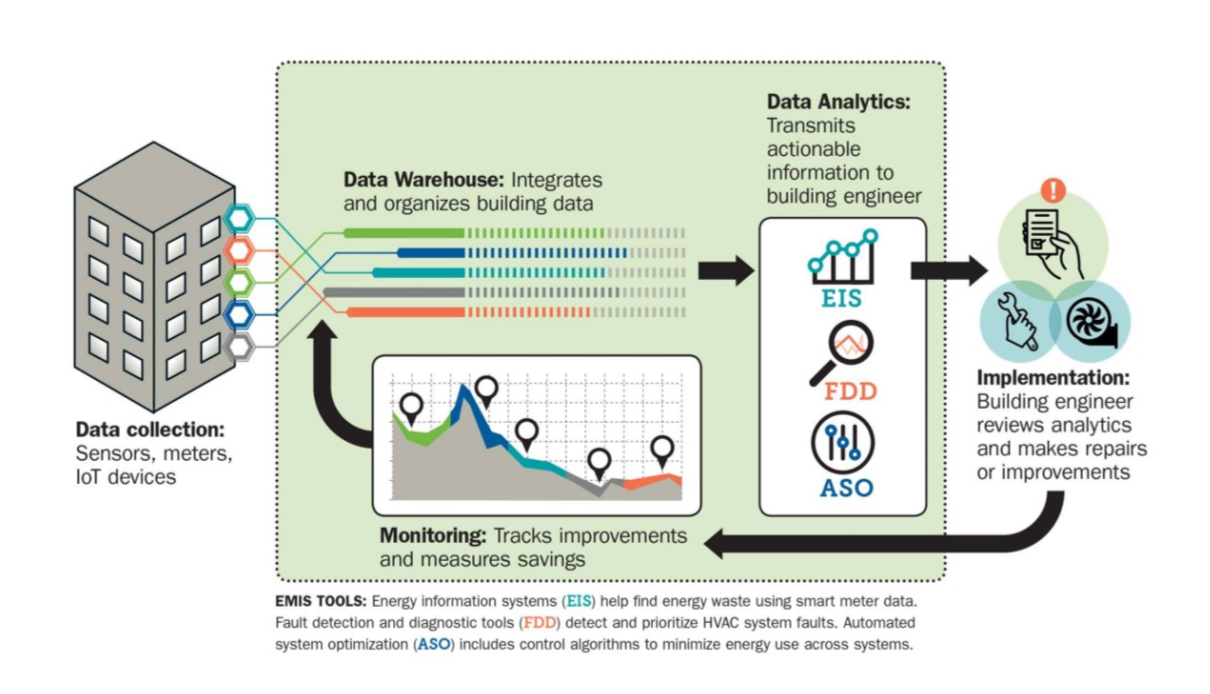Building energy management and control systems in commercial buildings can benefit both property owners and occupants. Three new briefs examine the achievable savings, how AI is changing the technology, and strategies to help more buildings install these systems.
Many commercial buildings in the United States waste energy needlessly and have significant opportunities to become more efficient. Properties ranging from hospitals, to retail stores, to hotels can cut their utility bills by installing building energy management and control systems (BEMCS) that optimize heating, cooling, and other energy systems and help building operators understand how energy is being used and how to improve performance.
Advances in technology, including the rise of artificial intelligence (AI), have made these systems even more effective in recent years. ACEEE examines BEMCS and their potential to optimize buildings’ energy use in three briefs published today:
- Unlocking Energy Savings Using Building Energy Management Control Systems
- The Use of Artificial Intelligence in Building Energy Management Control Systems
- Building Energy Management Control Systems for Small and Medium Commercial Buildings
What are building energy management and control systems?
BEMCS—sometimes called energy management systems or building management systems—use sensors, meters, and software to monitor and optimize how a building uses energy. They can automatically adjust heating, cooling, and lighting and can help operators find and fix inefficiencies in real time.
A BEMCS can also coordinate demand response program participation, manage distributed generation, facilitate electric vehicle charging and storage, and interface with retail electricity markets. Together, the monitoring, diagnostics, and automated workflows enabled by one of these systems can drive significant energy and cost savings.
Figure 1. Overview of a BEMCS. Source: Kramer et al. 2020.
Effective implementation requires planning and communication
Read the Topic Brief Based on our review of published studies, we find in the first brief that organizations can reduce their energy use by 10–25% and enhance operational efficiency by using a BEMCS to control building systems.
An integrated approach is essential to successful implementation of a BEMCS. This means considering the specific needs and challenges of the building. Facility staff, building occupants, and managers all need to be part of the process. Clear communication through user-friendly, intuitive interfaces, automated controls, and collaboration among facility staff and management can encourage support for BEMCS initiatives.
The brief includes case studies on implementation at an office building in Denver, a Microsoft campus in Washington, and in a BC Hydro program for commercial customers.
AI is enhancing analytics to drive more energy savings
Read the Topic Brief In the second brief, we find that AI is transforming BEMCS, making them more intelligent, adaptive, and efficient. The application of AI, particularly in machine learning and automation, is rapidly becoming established in the buildings sector.
AI-driven BEMCS use advanced analytics, predictive modeling, and automation to optimize building operations. AI can identify patterns and anomalies in building data that traditional systems might miss, allowing dynamic responses to environmental changes, optimizing energy use, and enhancing safety.
The brief provides several case studies, including applications at Dollar Tree stores and a Finnish shopping center that produces its own energy. As additional use cases develop, we anticipate that AI will play a crucial role in fostering innovation in the building industry and helping achieve sustainability goals.
Policies and programs can help small and medium-sized buildings benefit
Read the Topic Brief In the third brief, we examine how smaller buildings can adopt BECMS. A 2018 survey by the Energy Information Administration found that BEMCS are common in large commercial buildings (floor area over 100,000 sq. ft.) but absent in about 75% of medium-sized commercial buildings (floor area of 10,000–50,000 sq. ft.) and 90% of small commercial buildings (floor area less than 10,000 sq. ft.). Owners of small and medium-sized buildings often face time, expertise, and financial constraints that hinder the adoption of BECMS. These problems are particularly acute for small buildings.
Education, training, and technical assistance programs, along the lines of the U.S. DOE Smarter Small Buildings Campaign, can help, as can financial incentives and building performance standards. Ultimately, new business models could help apply creative approaches to financing and maintaining systems while sharing in the economic value BEMCS can provide. Retail chains offer a good starting place for these efforts, as they have many similar buildings and projects can often be sold to central management rather than building-by-building marketing.
With smart systems and smarter policy, we can make these tools standard for every building
BEMCS have a strong record helping many large buildings across the country cut energy waste. These systems are getting smarter as AI capabilities grow. To reduce energy costs, curb pollution, and reduce strain on the grid, it’s time to expand the use of this powerful tool.




